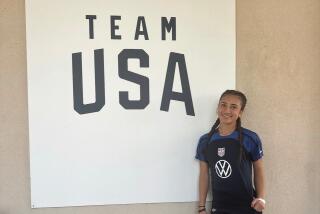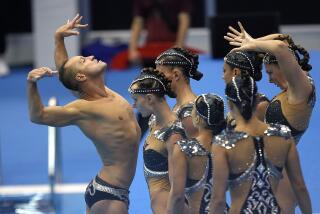SWIMMING : Olympic Trials Often Fiercest Competition for Americans
- Share via
The fastest 50-meter freestyle swimmers in the world last year were Americans Matt Biondi, Tom Jager and Steve Crocker.
But only two of them will advance from the Olympic trials, March 1-6 in Indianapolis, to the Olympic Games, starting July 25 in Barcelona, Spain.
In response to U.S. swimming dominance, FINA, the world governing body of the sport, decreased the number of entrants allowed each country from three per event to two in 1980.
Other international meets followed suit. That is why on the same day last August that Carl Lewis broke the world record in the 100 meters and celebrated on the victory stand with silver medalist Leroy Burrell and bronze medalist Dennis Mitchell, the third-fastest swimming sprinter in the world was relegated to the consolation heat at the Pan Pacific Championships while Jager and Biondi were awarded gold and silver medals.
Crocker, despite his senior status at 28, is new to the rivalry. He is not new to being the odd man out. In the morning heats at the Pan Pacific Championships, he beat Jager, an All-American from UCLA, in a personal-best 22.32 seconds. But officials ruled that Jager’s heat had been started incorrectly.
Thirty minutes later, the heat was contested again, and Jager clocked a 22.31 to advance to the final at Crocker’s expense. Jager’s superior start in the final gave him the edge over Biondi, 22.21 to 22.30.
If Biondi does not make the team in the 50, he undoubtedly will make it in the 100 freestyle or the 100 butterfly. The same cannot be said of Jager and Crocker. Crocker does not swim other events, and Jager is a longshot for a top-four finish in the 100 freestyle, which would give him a berth on the 400 freestyle relay team.
The U.S. women have the top three world rankings in two events, the 100 freestyle and the 200 breaststroke. At least in the 100 freestyle, the third-place finisher at the trials is an automatic member of the 400 freestyle relay team.
But as in the case of Biondi, Jager and Crocker, one of the world’s best female 200 breast-strokers--Anita Nall, Kristine Quance or Dorsey Tierney--will be left out.
U.S. Swimming did not have much bargaining power in 1980 because the United States boycotted the Olympics. In exchange for reducing the number of entries per country, the 200 individual medley and the 400 freestyle were reinstated after being left out of the 1976 Games.
Ron Karnaugh, Eric Diehl and Lisa Jacob, the Mission Viejo Nadadores’ leading Olympic candidates, spent three days last week in Indianapolis, acclimatizing themselves.
For the next 3 1/2 weeks, the group of Pan American Games gold medalists will train at high altitude at the Olympic Training Center in Colorado Springs.
At altitude, the body compensates for the lack of oxygen. Theoretically, when the swimmer returns to sea level, there is more oxygen available and the body overcompensates, supposedly improving performance.
Before the 1988 Olympics, Mission Viejo Coach Terry Stoddard did not schedule altitude training.
“I didn’t really know enough about it,” he said. “I felt the need to do it, but I didn’t feel a driving force to do it.”
Stoddard took his swimmers up to altitude before the Pan American Games last summer, which reinforced his plan to train at altitude before this year’s Olympic trials.
“The longer the race, the more you should consider it,” Stoddard said. “There’s no question in my mind that we can (finish fast) in our races because of this. When you’re trying to win by one-hundredth of a second, you should consider all things that could help.”
Altitude training has long been a weapon of the Germans, who were recently in Flagstaff, Ariz., and was pioneered in the United States by Ohio State Coach Jim Montrella, who coached at the Lakewood Aquatic Club in Southern California during the early 1970s.
The Nadadores’ preparations for the trials also involved sessions last month with several top Australians, including 800 freestyle world record-holder Kieren Perkins, distance freestylers Glen Housman and Haley Lewis and breaststroker Samantha Riley.
It would have been impressive enough if Pablo Morales had simply qualified for the Olympic trials in his first competitive race in 3 1/2 years. But Morales swam the eighth-fastest time in the world in the 100-meter butterfly last month at the U.S. Open in Minneapolis. His time of 54.18 seconds was well under the 55.59 needed to reach the trials. Only three Americans--Brian Alderman (53.38), Mark Henderson (53.81) and Matt Biondi (53.97)--swam faster than Morales in 1991.
Morales, who resumed training last summer, holds the world record in the event--52.84, set in 1986.
The USC women’s team moved into the top-10 rankings with an upset of Michigan on Jan. 4, but the ninth-ranked Trojans did not improve their ranking after beating No. 5 California the next week. Cal lost the meet in the final event because one of the Bear swimmers jumped into the water before everyone had finished swimming and was disqualified.
Trojan sprinter Ellen Bartell has shown great improvement, and freshmen Elizabeth Barnhardt, Cristin Grant and Ulrike Reinholdt of Germany have been important additions. Moreover, sophomore Jennifer Hutchison is swimming personal-best times only a few months after recovering from a broken arm.
Swimming Notes
The last U.S. appearance by the nation’s Olympic team before the Summer Games will be in the Southland. The Olympic Sendoff Meet July 3-5 will be held at Mission Viejo’s International Swimming Complex. . . . Of the 14 world records set last year, the latest, Martin Zubero’s 1:56.57 in the 200-meter backstroke on Nov. 23, was the only one set in a minor competition, the Rammer Jammer Invitational at Tuscaloosa, Ala.
After a four-year absence, the Northern California vs. Southern California All-Star meet has been revived. It pits the top 16 male and female age-group swimmers in Southern California against the top 16 in Northern California. The swimmers were selected at the qualifying meet during the weekend and will compete Saturday at the University of San Francisco’s new swimming complex. Bud McAllister of CLASS Aquatics will coach the Southern California girls, and Larry Liebowitz of Santa Barbara will coach the boys. . . . UCLA freshman Natalie Norberg set a rare in-season school record with a 4:44.27 in the 500-yard freestyle.
Michigan’s 121-120 victory over the USC men earlier this month ended the Trojans’ winning streak at 28 dual meets. . . . The Wolverines won without Eric Namesnik and Eric Wunderlich, who dropped out of school for the semester to prepare for the Olympic trials. . . . One of the best races was the 50-meter freestyle showdown between Michigan freshman Gustavo Borges and USC junior Robert Pulfleb. Borges, who is 6 feet 7, edged the 6-8 Pulfleb, 23.94 to 24.22. After their reunion in the NCAA meet, they are expected to meet again in Barcelona. Borges is on the Brazilian Olympic team, and Pulfleb swims for Germany.
Two of the three women USC signed to national letters of intent in the fall are from Canada--Olympian Mojca Cater and Petrina Lessard. Cater is a transfer from the University of Toronto who is training in Napa with Tracy Caulkins’ former coach, Paul Bergen. Lessard, a freestyler from Quebec and a finalist in the 1991 Pan Pacific Championships, attended the same high school--John Rennie--as Trojan Jennifer Hutchison. . . . Distance freestyler Megan Holliday is also from Canada, as are two members of the men’s team--senior Gary Anderson, a 1988 Olympian, and freshman Andy Trussler. Trojan Coach Darrell Fick also signed freestyler Jennifer Stephen of Porterville.
UCLA men’s Coach Ron Ballatore signed four senior national finalists in the early period: butterflyer-medleyist Randy Hartley of Santa Maria, backstroker Michael Andrews of Cincinnati, backstroker Robert Ritter of Owings, Md., and backstroker-medleyist Wyatt Russo of Plano, Tex. . . . Former USC All-American David Wharton won an NCAA Top Six Award for his athletic and academic achievement as well as his leadership and community service. Wharton, who is ranked in the top five in the world in two events, was born with a 50% hearing loss.
Kristine Quance is benefiting from the eight-week winter break implemented by the Los Angeles Unified School District in the current school year. The Granada Hills High junior, who trains at CLASS Aquatics, sleeps between her 5:15-7 morning workout and her 3:30-6 p.m. afternoon session.
Calendar: National--Olympic prep meet, San Antonio, Feb. 7-9. NCAA men--Stanford at USC, Jan. 31. NCAA women--USC at UCLA, Saturday; Pacific 10 Championships, Belmont Plaza, Long Beach, Feb. 7-9. Local--Northern California All-Stars vs. Southern California All-Stars, USF, Saturday; Southern California Spring Senior Championships, Cerritos Olympic Swim Center, Jan. 30-Feb. 2.
More to Read
Go beyond the scoreboard
Get the latest on L.A.'s teams in the daily Sports Report newsletter.
You may occasionally receive promotional content from the Los Angeles Times.






